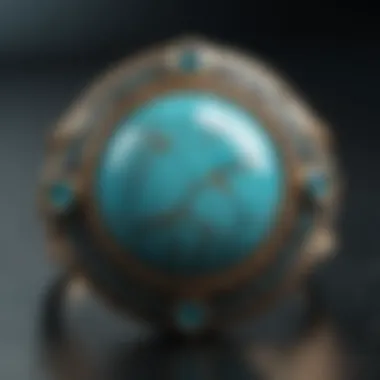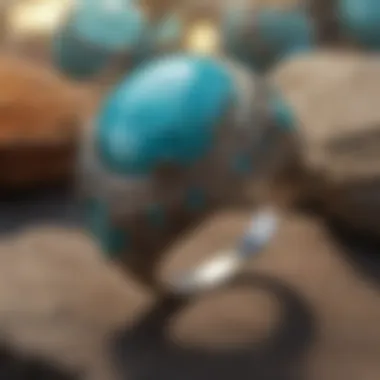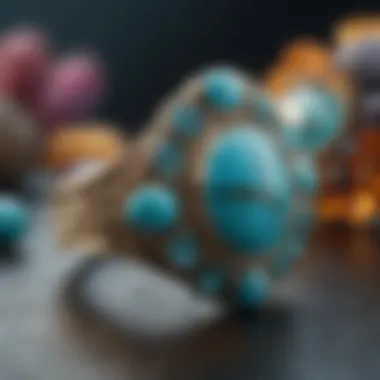Understanding the Value of Turquoise Rings


Intro
Turquoise rings have fascinated individuals for centuries, both for their stunning aesthetic appeal and their rich history. The value of these rings is influenced by a multitude of factors, making it essential for collectors and enthusiasts to comprehend the intricate dynamics at play. This article aims to dissect the various elements that contribute to the valuation of turquoise rings, providing a nuanced understanding of their worth from multiple perspectives.
Gemstone Overview
Description of the gemstone
Turquoise is an opaque, blue-to-green mineral that has been prized for its unique color and beauty. Its vibrant hues, often marked with veins of matrix or pyrite, create a visual complexity that differentiates one piece from another. Historically, turquoise was used in jewelry by various ancient cultures, including the Egyptians and Native Americans, and continues to be revered in modern times. The gemstone is typically found in arid regions, where it forms through a variety of geological processes.
Physical properties
The composition of turquoise predominantly consists of hydrous copper and aluminum phosphate. It has a hardness that typically ranges between 5 and 6 on the Mohs scale, making it reasonably durable yet still vulnerable to scratches and wear. Its color can vary significantly based on geographical origin, mineral content, and even treatment methods. Not just the color, but the overall transparency—and occasionally, surface smoothness—can greatly affect the desirability and consequently the price of turquoise rings.
Factors Influencing Value
A number of factors can influence the value of turquoise rings. Below are some key aspects:
- Color variations: The most desirable turquoise is often a rich, uniform blue. However, variations such as green or those with a prominent matrix can still hold significant value.
- Quality grading: Not all turquoise is created equal. Professionals grade the stone based on its color, matrix presence, and overall appearance, influencing the final valuation.
- Craftsmanship: As with any jewelry piece, the level of craftsmanship involved in creating the ring can greatly impact its value. Intricate designs or high-quality metals can enhance the appeal and price.
"Understanding the color and quality distinctions in turquoise is pivotal for informed purchasing decisions."
Healing Properties
Metaphysical attributes
Turquoise is often associated with various metaphysical properties. Many believe that it promotes healing, balance, and communication. Its calming color is said to facilitate peace and tranquility. Turquoise is also thought to serve as a protective stone, warding off negative energies and fostering emotional stability.
Common uses in holistic practices
In holistic practices, turquoise is utilized in various forms. It’s common to see turquoise in meditation sessions, where it's used to help open and align the throat chakra, aimed at enhancing communication.
Furthermore, some holistic practitioners incorporate turquoise in crystal healing, believing that it can assist in alleviating stress, supporting intuition, and fostering a stronger connection to one’s self and surroundings.
By understanding these facets of turquoise rings, potential buyers can make informed decisions rooted in both financial and emotional valuations.
Preface to Turquoise Rings
Turquoise rings hold not just beauty but rich significance in the jewelry world. For enthusiasts and collectors, understanding the intricacies behind these rings is essential. They are more than mere accessories; they encapsulate history, artistry, and the potential for investment. Each turquoise ring possesses unique qualities that contribute to its value, making awareness of these factors vital for informed purchasing. In a market that constantly evolves, recognizing the subtleties of turquoise can enhance one’s appreciation and selection process.
Overview of Turquoise as a Gemstone
Turquoise is a hydrous phosphate of copper and aluminum, renowned for its stunning hues that range from robin's egg blue to deep blue-green. The unique color variations are influenced by the mineral content within the stone. For collectors, the most coveted pieces exhibit a vibrant and even color distribution, unmarred by excessive veining or discoloration. Turquoise is also characterized by its relatively low hardness, typically sitting at 5 to 6 on the Mohs scale. This property makes it somewhat delicate, warranting careful handling and maintenance.
Turquoise is not only valued for its aesthetics but also for its metaphysical properties. Many believe it embodies healing and protective energies. This belief, combined with its visual appeal, solidifies its presence in both modern and ancient jewelry.
Historical Context of Turquoise in Jewelry
The significance of turquoise in jewelry can be traced back thousands of years, underscoring its archaeological and cultural importance. Ancient civilizations, particularly the Egyptians, revered turquoise, often associating it with protection from evil. They adorned their pharaohs with turquoise ornaments, thinking it would ensure safe passage into the afterlife. Moreover, the Native Americans have incorporated turquoise into their spiritual practices for centuries. For them, it signifies protection, peace, and harmony.
In contemporary contexts, turquoise continues to reflect a connection to its rich heritage. It has transitioned from a symbol of status and protection to a representation of personal expression in modern jewelry. As such, understanding this historical background provides insights into its intrinsic value, making any turquoise ring a conversation piece rooted in time.
Factors Influencing Value
The value of turquoise rings does not arise from a single characteristic; instead, it is an amalgamation of diverse factors that contribute to the overall worth of the gemstone and settings. Each factor plays a significant role not just in determining price points but also in reflecting the quality and desirability among collectors and enthusiasts.
Understanding these components leads to more informed purchases and investment decisions. Collectors should be aware of how each aspect interacts, thereby fostering a deeper appreciation for this unique gemstone.


Color and Its Impact on Value
Color is one of the most critical factors influencing the value of turquoise. Variations exist, ranging from sky blue to greenish hues, with certain tones being more desirable than others. The most prized shade is a vibrant, rich blue, often referred to as "robin's egg blue."
Factors to consider include:
- Uniformity: Consistent coloration across the stone is highly valued.
- Matrix: Presence of matrix patterns can either enhance or diminish value, depending on personal taste.
In general, the saturation and clarity of the color can significantly elevate the market value of turquoise rings.
Quality Grading of Turquoise
Quality grading of turquoise is essential for potential buyers. This grading system is often based on various characteristics, including hue, matrix, and overall health of the stone.
Natural vs. Stabilized Turquoise
Natural turquoise is formed through geological processes and retains its raw characteristics. Meanwhile, stabilized turquoise has undergone treatment to enhance its durability and color. Here are the distinctions:
- Natural Turquoise: Typically more sought after, retains its unaltered form, appealing to purists.
- Stabilized Turquoise: More affordable and can offer robustness against wear, making it a popular option for everyday jewelry.
However, the treatment may lower its overall market value for collectors seeking authentic stones.
Characteristics of High-Quality Turquoise
High-quality turquoise is characterized by several distinct features, which can heavily influence its desirability:
- Color: Deep, vivid blue is often seen as the hallmark of superior turquoise.
- Texture: Smoothness and lack of imperfections indicate a high-quality specimen.
Each of these features impacts the market value and ensures that the piece attracts the right buyers, especially collectors looking for premium items.
Craftsmanship and Design Variations
The craftsmanship behind turquoise rings is another essential element influencing value. Skilled artisans create designs that enhance the intrinsic beauty of the stone. Unique cuts and settings can set rings apart in the market.
Considerations include:
- Setting Type: The choice between silver or gold, along with intricate designs, affects overall appeal.
- Artisan Skill: Rings created by recognized artisans may command higher prices due to craftsmanship reputation.
Ultimately, the combination of design and quality of materials significantly impacts value.
Turquoise Mining Locations
Understanding the mining locations of turquoise is essential in evaluating the gemstones' value and authenticity. These sites have a significant impact on the quality, rarity, and ultimately, the pricing of turquoise rings. The geographical origin is often tied to the specific characteristics of the stone, shaping its aesthetic and market appeal.
Turquoise mining is not merely about extraction; it also encompasses a rich history that connects various cultures to the gemstone. Different locations yield unique variations of turquoise, each with its distinct visual appeal. This can be a critical factor when collectors seek to make informed purchases. Moreover, knowledge of mining regions aids in recognizing ethical sourcing practices, which is increasingly important in today's market.
Major Turquoise Mines in the World
Turquoise is mined in several prominent regions globally, and each has unique attributes. Some of the most notable mines include:
- Sleeping Beauty Mine, Arizona: Known for its sky-blue color, it produces high-quality stones with minimal veining.
- Kingman Mine, Arizona: One of the oldest turquoise mines, it yields a vibrant blue stone with distinct characteristics.
- Chalk Mountain, Nevada: Offers a variety of colors from blue to green, often with a unique matrix.
- Persian Turquoise: Sourced from Iran, it is highly prized for its deep blue hue and fine texture.
Each of these mines contributes to the broader narrative of turquoise mineralogy and its cultural significance. Their stones often hold a premium in the market due to their unique properties and historical contexts.
Regional Characteristics Affecting Value
The value of turquoise is heavily influenced by the geological conditions in which it is found. Various regions offer different minerals and environmental factors that play a role in the formation of the stone:


- Color: Turquoise from certain areas may have more intense colors compared to others, directly impacting its desirability.
- Matrix Patterns: The presence of matrix lines can vary in strength and contrast, altering the stone's appearance and value.
- Hardness: Turquoise durability is influenced by mineral content, which can differ by location. Harder turquoise is often more sought after, as it withstands wear better.
- Extraction Methods: The techniques used in mining can affect how well the stone retains its natural state, thus influencing market value.
In summary, understanding these regional characteristics is vital for anyone interested in investing in turquoise, as they fundamentally shape the qualities that define its market appeal.
Market Dynamics of Turquoise Rings
Understanding the market dynamics of turquoise rings is essential for anyone interested in this unique gemstone. Market dynamics refer to the forces that affect the pricing and availability of turquoise rings. Several elements contribute to these dynamics, including supply and demand, trends in fashion, and the overall economic environment. By grasping these factors, collectors and enthusiasts can make informed decisions when purchasing turquoise jewelry, ensuring that their investments hold value over time.
Current Market Trends
In recent years, there has been a notable resurgence in the popularity of turquoise jewelry. This renewed interest can be linked to various factors.
- Fashion Influence: Turquoise rings are being increasingly featured by designers and in fashion shows. Their vibrant color and unique appeal make them a favorite choice in contemporary jewelry design.
- Cultural Significance: Many consumers are drawn to the historical and cultural heritage associated with turquoise. This includes the gemstone's significance among Native American tribes, adding personal and emotional value to the pieces.
- Sustainability Concerns: A focus on ethical sourcing and sustainable mining practices has fostered a market for responsibly sourced turquoise. Buyers are becoming more aware of where their jewelry comes from and prefer items aligned with their values.
Furthermore, social media platforms like Instagram and Pinterest have amplified trends in turquoise jewelry, pushing its popularity among a younger demographic. These platforms allow artists and collectors to showcase their work, increasing awareness and interest in turquoise rings.
Investment Potential of Turquoise Rings
The investment potential of turquoise rings should not be overlooked. While many view jewelry simply as adornment, certain rings can appreciate over time. Here are some factors to consider when evaluating the investment potential:
- Rarity: Pieces that feature rare colors or come from specific mines, such as the Sleeping Beauty or Kingman mines, often command higher prices.
- Quality: The quality of the turquoise, based on its color saturation and absence of matrix (the host rock), plays a significant role in value appreciation. High-quality stones can increase in value substantially over the years.
- Craftsmanship: Work that reflects superior craftsmanship adds to a ring's desirability. Signed pieces, or those created by well-known artisans, can prove to be wise investments.
"Investing in turquoise rings combines beauty with financial prudence, making it a compelling choice for discerning buyers."
Understanding these dynamics allows potential investors to make educated choices. Whether for personal enjoyment or financial gain, investing in turquoise rings can offer gratifying rewards.
Assessing Authenticity of Turquoise
Evaluating the authenticity of turquoise is critical in the realm of jewelry. As turquoise rings gain popularity, the presence of imitation stones grows too. Therefore, discerning between genuine and artificial turquoise becomes essential for both buyers and collectors. Authenticity not only affects the value but also the significance of the piece. Genuine turquoise carries historical and cultural weight, while imitations lack this depth. Understanding how to assess authenticity ensures informed purchasing decisions.
Common Forgery Techniques
Understanding common forgery techniques is vital for anyone interested in turquoise rings. Here are some prevalent methods used by forgers:
- Imitation Stones: Manufacturers often use dyed howlite or plastic to mimic the appearance of real turquoise. This can mislead even experienced collectors.
- Color Treatments: Artificial processes can alter the natural color of lower-quality stones to make them appear more valuable.
- Composite Turquoise: This technique involves combining genuine turquoise with resin or other materials. The end result resembles real turquoise, but lacks its essential properties.
Awareness of these forgery techniques helps buyers remain cautious and make educated choices when acquiring turquoise rings.
Testing Methods for Authenticity
Verifying authenticity can be accomplished through various testing methods. Two commonly used methods are visual examination and laboratory testing.
Visual Examination
Visual examination offers a quick approach to assessing turquoise rings. When done correctly, it allows for a preliminary evaluation of the stone's characteristics.
- Key Characteristics: Color, matrix patterns, and texture are essential features to observe. Genuine turquoise often showcases a unique matrix of veins or spots, differing from smooth or uniform surfaces indicative of imitations.
- Benefits: This method is non-invasive and requires no special equipment, making it accessible for most buyers.
- Disadvantages: Visual examination requires a trained eye and may not be sufficient for definitive results. In many cases, it can be misleading if the observer is not familiar with authentic turquoise characteristics.
Laboratory Testing
Laboratory testing presents a more thorough method for authenticity verification. It involves scientific techniques to analyze the material composition of the stone.
- Key Characteristics: Professional labs utilize advanced technologies to perform tests such as spectroscopy and chemical analysis.
- Benefits: This method yields reliable results and can precisely identify the mineral composition. It assures buyers of the gemstone's authenticity beyond doubt.
- Disadvantages: The main drawback is cost and time involved. Laboratory testing generally requires sending the stone for analysis, which may delay the purchase process.
Authenticity assessment is crucial in the turquoise market; understanding testing methods enables buyers to separate genuine pieces from forgeries.
Ethical Considerations in Turquoise Sourcing


As interest in turquoise rings grows, so does the importance of understanding the ethical dimensions of their sourcing. This section discusses critical considerations that impact the value and desirability of turquoise, which goes beyond mere market dynamics or aesthetic appeal. Ethical sourcing ensures that the gems are obtained in a manner that supports sustainable practices and respects the rights of local communities.
Sustainable Mining Practices
Sustainable mining practices play a crucial role in the ethical acquisition of turquoise. These practices aim to minimize environmental impact while ensuring the welfare of local miners. Here are some key aspects:
- Land Restoration: Responsible mining companies engage in land restoration efforts post-extraction. This involves rehabilitating mined areas to protect local ecosystems.
- Water Use Management: Efficient management of water resources is critical in mining operations. Minimizing water usage helps preserve this essential resource for communities.
- Worker Safety and Wages: Sustainable practices often include fair compensation for miners and safe working conditions, which can improve their standard of living significantly.
Adhering to sustainable mining practices not only protects the environment but also fosters a positive image for brands and artisans involved in the turquoise market. It attracts ethically conscious buyers who are willing to pay a premium for responsibly sourced gemstones.
Fair Trade and its Importance
Fair Trade principles are important in the context of turquoise sourcing. This concept extends beyond environmental issues to encompass social equity and economic justice. To emphasize its significance, consider the following points:
- Empowering Local Communities: Fair Trade initiatives can empower local artisans and miners by providing them with fair compensation and ownership over their work processes. This leads to sustainable community development.
- Transparency in Supply Chains: The Fair Trade certification process promotes transparency, allowing consumers to make informed choices about the products they purchase. Knowing that their gemstone comes from a reputable source not only enhances buyer confidence but also boosts brand loyalty.
- Quality Assurance: With Fair Trade practices come expectations for quality and authenticity. This can ensure that the turquoise rings produced meet a high standard, further elevating their value in the market.
Incorporating Fair Trade principles can significantly enhance the value of turquoise rings. By supporting ethical practices, consumers play a part in creating a positive economic impact on communities involved in the production of these exquisite gems.
"Ethical sourcing is not just a trend; it is an essential aspect of responsible consumption that can lead to sustainable outcomes for both the planet and its people."
In summary, ethical considerations in turquoise sourcing extend beyond pricing. They encompass sustainable practices and fair trade, which are increasingly valued by consumers. Buyers are willing to support brands and artisans who prioritize ethical sourcing, ultimately influencing market dynamics and the perception of turquoise rings.
Care and Maintenance of Turquoise Rings
Understanding the care and maintenance of turquoise rings is essential for anyone who appreciates this unique gemstone. Proper maintenance optimizes the ring's longevity and helps retain its aesthetic appeal. Over time, turquoise can be susceptible to various damages if not cared for correctly. For collectors or enthusiasts, preserving the value of their jewelry is paramount. Therefore, knowing how to clean, store, and avoid common damages becomes more than just routine—it is a necessity.
Cleaning and Storage Recommendations
Keeping turquoise rings clean and stored correctly plays a significant role in maintaining their beauty. To clean these rings, avoid aggressive chemicals or abrasive materials. Instead, use a soft cloth to wipe away any dust and oils that accumulate from daily wear. A solution of mild soap and lukewarm water can effectively remove stubborn dirt.
When it comes to storing your turquoise rings, consider these key points:
- Store separately: Always keep turquoise rings in a soft pouch or a separate compartment in a jewelry box. This prevents scratches from harder metals or stones.
- Avoid moisture: Since turquoise is porous, it can absorb moisture, leading to discoloration. Store your rings in a dry area, away from humidity.
- Limit exposure to sunlight: Prolonged exposure to direct sunlight can fade turquoise over time. Therefore, store them in a shaded area.
Avoiding Common Damages
Turquoise, while stunning, is softer and more vulnerable than many other gemstones. Therefore, understanding how to avoid common damages is crucial for preserving its condition.
Consider the following advice:
- Remove when engaging in activities: When participating in sports, household chores, or swimming, take off your turquoise rings. Physical impacts can chip or scratch the stone.
- Limit exposure to chemicals: Household cleaners, perfumes, and even lotions can damage turquoise. Always apply such items before putting on your jewelry.
- Regularly inspect your jewelry: Routinely check your turquoise rings for signs of wear. This simple habit can help identify issues before they worsen, preserving not just the ring’s appearance but its value as well.
Proper care is a small investment of time that can yield substantial returns in preserving the integrity and value of turquoise rings.
End
The conclusion acts as a vital element of this article by synthesizing the wealth of information presented about turquoise rings. A comprehensive understanding of the various factors influencing the value of these beautiful pieces is essential for anyone interested in collecting or investing in this gemstone. Throughout the article, we explored critical aspects such as color variations, quality grading, and the significance of craftsmanship, all of which play a pivotal role in determining value.
Recap of Key Value Factors
When discussing the value of turquoise rings, numerous factors are particularly noteworthy:
- Color: The hue of the turquoise can significantly influence its desirability and price. Clear, vibrant colors fetch a premium compared to muted or dull tones.
- Quality Grading: Distinguishing between natural and stabilized turquoise is crucial. High-quality, natural stones are often more valuable and sought after.
- Craftsmanship: The skills and design of the artisan can elevate a simple turquoise ring to a piece of art. Intricate designs and unique settings can enhance value.
All these components merge to form a comprehensive picture for buyers and collectors, helping them make informed decisions.
Future Trends in Turquoise Rings
Examining the future trends in turquoise rings reveals several emerging dynamics:
- Ethical Sourcing: As consumers become more conscious about sourcing, the demand for ethically mined turquoise is expected to grow.
- Sustainable Practices: Mining practices are shifting towards sustainability and minimizing environmental impact, enhancing the gemstone's appeal to conscious buyers.
- Customization: Jewelry trends are leaning towards personalized pieces, encouraging more unique designs that resonate with individual customers.
"In the world of gemstones, knowing the market dynamics and ethical implications can lead to wiser investment decisions."
Engaging with the future landscape of turquoise can open doors to opportunities and allow enthusiasts to enrich their collections meaningfully.







